 |
| Roadside Hawk, Rio Magnolia Lodge, Costa Rica |
As the end of the year rapidly approaches I will take some time to review the highlights of the year of 2011. The total number of birds seen this year topped out at 583 with a total of 449 of those seen in the United States and the rest in Costa Rica. I added 152 life birds with 121 of those coming from Costa Rica. Overall my most productive year to date.
I took a total of six trips out of the area this year, which was a new high for me. The trips included the following: Florida in January, Arizona in April, Ohio in May, California in September, Texas in November and Costa Rica in December. Each of these trips had their own set of highlights.
 |
| Pied-billed Grebe, Green Cay Wetlands, FL |
 |
| Black-bellied Plover, Sanibel Island, FL |
 |
| Eastern Screech Owl, J.N. Darling NWR, FL |
 |
| Florida Scrub Jay, Canaveral National Seashore, FL |
The trip to Florida was a nice getaway from the cold winter up north. We spent a little time on the Atlantic coast near Boynton Beach and then made a trip over to the gulf coast to Sanibel Island and then up to the Orlando area.
 |
| Verdin, Saguaro NP, AZ |
 |
| Pyrrhuloxia, Tucson, AZ |
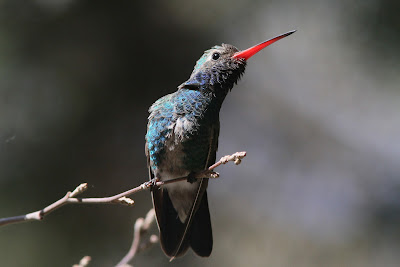 |
| Broad-billed Hummingbird, Madera Canyon, AZ |
 |
| Hepatic Tanager, Madera Canyon, AZ |
The Arizona trip was another nice late winter/early spring getaway that provided many noteworthy birds. I visited Mount Lemmon, Sweetwater Wetlands, Saguaro NP (both units) as well as spending a few days in Madera Canyon. The weather was just perfect with only one day with any bad weather and that was the day we arrived in the rain. Otherwise it was sunny and warm during the day and clear and cool at night.
 |
| American Redstart, Magee Marsh, OH |
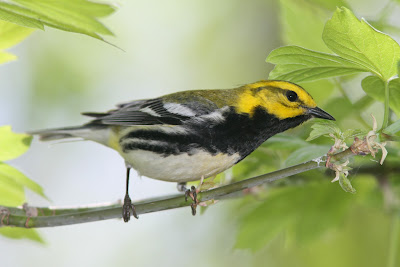 |
| Black-throated Green Warbler, Magee Marsh, OH |
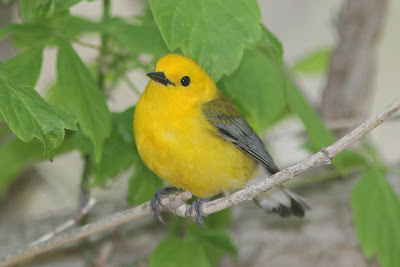 |
| Prothonotary Warbler, Magee Marsh, OH |
 |
| Blackpoll Warbler, Magee Marsh, OH |
 |
| Blackburnian Warbler, Magee Marsh, OH |
I then took a solo trip out to Ohio to visit the area around Magee Marsh along the shoreline of the great lakes where many neotropical migrants stack up during migration before continuing their trip north across the lake. Many species of warblers, vireos, thrushes, orioles, etc can be seen at nearly arms length as they feed along the boardwalk. It was once again a dream for photography. On one rainy day I decided to make the long drive up into Michigan to get to sunnier weather and see Kirtland’s Warblers on their breeding grounds.
 |
| Western Scrub Jay, Point Reyes, CA |
 |
| Black-footed Albatross, Monterey Bay, CA |
Our trip to California added quite a few species to my list for the year as well as several new species to my life list. We stayed a few days around Point Reyes and then down to Monterey to take an all day pelagic trip and then down to Big Sur. A truly beautiful area.
 |
| Green Jay, Bentsen-Rio Grande Valley SP, TX |
 |
| Green Kingfisher, Santa Ana NWR, TX |
I took a second solo trip for the year when I went down to south Texas along the Rio Grande. A little warm up to tropical birding before our trip down to Costa Rica. It was nice to get back down there again and see the varied selection of both birds and butterflies.
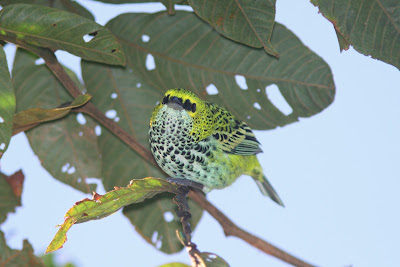 |
| Speckled Tanager, Rio Magnolia Lodge, Costa Rica |
 |
| Rufous-tailed Hummingbird, Hacienda Baru, Costa Rica |
 |
| Blue Dacnis, Hacienda Baru, Costa Rica |
 |
| Silver Throated Tanager, Rio Magnolia Lodge, Costa Rica |
The final out of area trip was down to Costa Rica which turned out to be the best trip of the year. We were a bit apprehensive of going down but we were so glad we did. The birds, the lodging, the food, and the weather were just great. It was one of the best trips I have ever had with little to no stress and lots of relaxation. Our only regret is not staying longer!
 |
| Sooty Tern (cropped, distant shot), Quabbin Park during Hurricane Irene |
As far as in the local area there were several highlights with one of the most memorable birding days being the day Hurricane/Tropical Storm Irene struck the area on August 28th bringing with it a lot of rain and a lot of storm driven birds. I will recount a bit of that day. I made several morning trips over to Winsor Dam at Quabbin and the rain and wind made viewing difficult to downright impossible. From mid morning on Marshal Iliff arrived and kept a vigil throughout the day as did Scott Surner a little later in the morning. I finally made another trip over and stayed as the storm made its way to the west of us. The first bird of note was a calling Whimbrel that we attempted to locate along the dam without any luck. We were pulled away from this search by Marshall who spotted a Parasictic Jaeger. This turned out to be the beginning of a parade of unusual birds. We spotted a group of Hudsonian Godwits as well as Black bellied and American Golden Plovers as they moved south passing over the dam. The biggest thrill was when I spotted a white bird coming over the hill at Quabbin Park which banked revealing its ID…White tailed Tropicbird. I immediately said “I think I have something interesting” and got others on it. It was amazing to see a tropical pelagic bird normally found hundreds of miles away flying over and then landing on Quabbin. The birds continued fast and furious with a Sooty Tern feeding just off the dam, another jaeger, Black Terns, Ruddy Turnstones with a Pectoral Sandpiper in tow. One of my most memorable days of birding ever. My only regret was not staying a little longer to see the Leach’s Storm Petrel that moved south passing over the dam. Marshall's eBird checklist for the day is worth a look if you want a true feeling for the spectacular nature of the day: http://ebird.org/ebird/view/checklist?subID=S8749439 A few days after Irene I had one of my other great sightings of the year but one that was frustrating as well as I got such a brief look at the bird and was not able to get the camera up quick enough to document what was probably another mega bird. I was at Covey WMA in the morning and was near a small swamp and noticed a few nighthawks moving south. With the last nighthawks I noticed a large swift moving with them. It was much larger than a chimney swift in the same general vicinity. I got a brief look at it and was unable to refind the bird. It may very well have been a Black Swift from the caribbean that was displaced by the hurricane as there were several other records along the east coast of either Black Swifts or unidentifed large swift species during and immediately after the storm. Certainly the bird that got away from me this year.
 |
| Song Sparrow collecting nest material, Belchertown, MA |
 |
| Mallard with ducklings, Quabbin Park, MA |
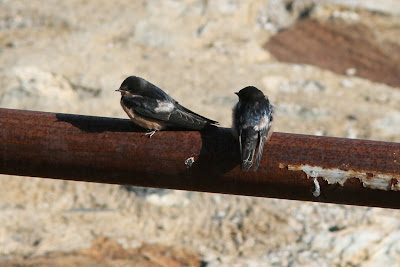 |
| Barn Swallow fledglings, Quabbin Park, MA |
 |
| Hooded Merganser with ducklings, Quabbin, MA |
This year also marked the end of the five year Massachusetts Breeding Bird Atlas. I will certainly miss going out in the field trying to track down all the various breeding birds in my assigned blocks. I will especially miss my trips down the restricted Prescott Peninsula which provided me with innumerable great experiences during the five years of the project. Finding one of the only records of breeding Red Crossbills during the atlas was a major highlight for me. Besides the atlas, I participated in other bird census research including a breeding bird survey route, Christmas bird counts, bird surveys and many contributions to eBird. The cornell eBird project is a great way to let your day to day sightings have scientific value as well being a great way to keep track of your own records. This year alone I submitted over 1900 eBird reports bringing my total to nearly 8000.
 |
| Red Phalarope, Quabbin Park, MA |
 |
| Wild Turkeys, Quabbin, MA |
 |
| Common Nighthawk, Belchertown, MA |
 |
| Mourning Warbler, Quabbin, MA |
 |
| Snow Buntings, Quabbin Park, MA |
 |
| Northern Pintails, Quabbin Park, MA |
There were many other great birding moments around the local area such as a Red Phalarope at Quabbin Park (a rare occurrence inland in the state), the annual arrival of various neotropical migrants, the August migration of Common Nighthawks, the September movement of raptors as they head south, the fall arrival of waterfowl, the winter arrival of birds from the north and on and on....
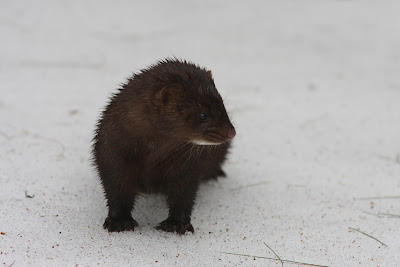 |
| Mink |
 |
| Rose-breasted Grosbeak, Amherst bike path, MA |
This year saw the loss of another birder in the area that I had gotten to know over the years. Deedee Minear lost her long battle with cancer. She was always a fixture along the rail trail in Amherst and I have many fond memories of running across her on a morning outing there in spring and comparing what we had come across so far. There were many times we were able to bird together for a bit and enjoy the antics of the resident Mink as it worked its way around the many marshy areas. I will always treasure the old Quabbin map she gave me several years ago as well as a copy of Donald Kroodsma’s book on bird song with a nice note in it about us meeting once along the bike path and enjoying the first of season sighting of a Rose-breasted Grosbeak.
 |
| Wilson helping me recover after surgery |
This year also marked the arrival of the newest member of the family, our new dog Wilson. He has filled a bit of the void left when we lost Kody but he is not looked at as a replacement. He has his own unique personality and has become a big part of our lives.













